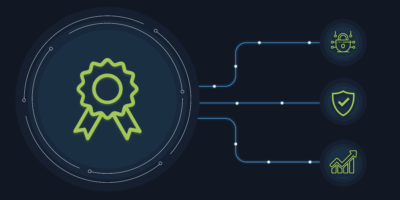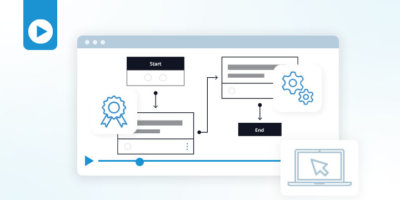You can’t have a compliant network without automation.
The goal of every network team is to efficiently build and maintain infrastructure so that it’s secure, reliable, and performs well. However, as the network has grown in size and complexity, it’s become increasingly difficult to ensure that every element is configured appropriately. The only way for network teams to accomplish this is with a better compliance solution than the current norm.
In response to a more demanding customer base, organizations must become more agile in their IT infrastructure, causing them to expect much more out of the network. To keep up with the pace of other technologies in the IT domain, network changes must be accomplished faster than ever before. This is where a problem arises – the only way to meet this developing need is for network teams to leverage a better automation solution.
Network teams know that a more modern method of achieving compliance and automation is needed, but what’s not so clear is just how important it is that these solutions work together in order to achieve their goal of quickly deploying a network that always adheres to the compliance standards.
Compliance Without Automation Creates More Manual Backlog
If you consider what the network looks like today compared to just a few years ago, it’s pretty astounding. Just five years ago, when we thought about “the network,” it was comprised of physical devices with a lot of wires and blinky lights. Over time, more network devices with more ports, wires, and lights were deployed and we segmented the networks into different domains based on their function. We had domains that included the data center, the campus, wireless, WAN, etc., and network teams often deployed different network vendor solutions for these domains.
Times have changed. In today’s network environment, organizations are deploying and managing more and more network elements that have no visible wires or blinky lights. These are cloud networking services, and they are completely different animals in the growing network zoo, yet they serve the same function as traditional networking and network teams must ensure that these cloud-native and cloud-based network services are configured within the same compliance standards as the on-prem network.
This rapid growth of the network from on-prem into the cloud has led to an increased network complexity that existing compliance tools simply cannot address. The compliance tools of the past networking era are limited in scope, scale, and features. They can’t keep up with the pace of supporting all the different vendors that teams were deploying in the on-prem network, and they had severe limitations in regard to automation. These tools can generate compliance reports, but still required a human to remediate the devices. Network teams dealt with all these limitations, and used them to the best of their abilities, but that still meant that only parts of the network were compliant, and ultimately created more manual backlog as the network grew in size and complexity.
Automation Without Compliance Creates Additional Bad Network Configurations
Making network changes manually has become a bottleneck in the plan to deploy IT infrastructure rapidly. If network teams are expected to deploy and change the network more rapidly than ever before, they must adopt new automation techniques in order to see success. This automation solution has to address the entire network infrastructure, on-prem and cloud. But, if your focus is only on automating infrastructure quickly, this can also lead to an even greater proportion of the network that is not in compliance.
If you need confirmation of this, consider how quickly you can automate the deployment of infrastructure on a cloud platform. Now consider how much of your own organization’s infrastructure is already deployed within one or more cloud platforms. How much of that automation process was focused on ensuring that the cloud infrastructure was compliant, and how do you determine that the same cloud infrastructure is now compliant?
Automation alone may solve the problem of reducing manual processes to deploy network changes quickly, but it can also lead to more compliance issues in the newly deployed infrastructure. These are compliance issues in areas of the network that the tools of the past era cannot address causing network teams to return to manual processes of remediation, ironically completing a cycle that keeps them from ever fully realizing the goal of efficiently building and maintaining the infrastructure so that it’s secure, reliable, and performs well.
Breaking the Cycle With Itential’s Automation Platform
The Itential Automation Platform provides network teams with a modern platform that couples compliance and automation together so they no longer have to be managed in pockets. By taking a collaborative approach, teams can achieve the goal of quickly deploying any network infrastructure, whether on-prem or cloud, that’s compliant from the first day to the last.
With the Itential Configuration Manager application, network teams can get started building Golden Configuration templates for CLI and API networking, running compliance reports across on-prem and cloud, and remediating any issues. Because compliance and automation are integrated into the same platform, network teams can leverage all of their Golden Configurations in Automation Studio to quickly build workflows that can automate compliance checks and remediation. These workflows are built on a drag-and-drop canvas and do not require writing any code. This allows the network team to accomplish both compliance and automation simultaneously, and as they continue down the automation journey, their automations can integrate with different IT systems, or become part of a self-service catalog.
To learn more about how compliance and automation work together in Itential’s platform, check out my recent on-demand webinar, “Modern Network Compliance: How Network Compliance Accelerates Automation.” If you’re ready to give it a try for yourself, sign up for a free account of Itential Cloud to start automating your compliance in minutes.




![[EMA] The State of Network Automation: Configuration Management Obstacles are Universal](https://www.itential.com/wp-content/uploads/2021/11/Featured-Analyst-Report-EMA-Research-The-State-of-Network-Automation-Configuration-Management-Obstacles-are-Universal-400x200.jpg)

